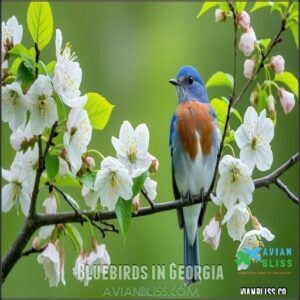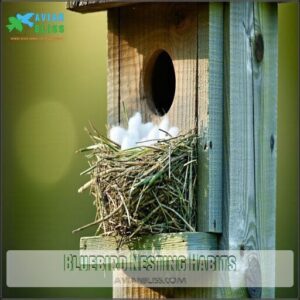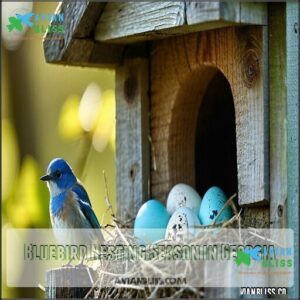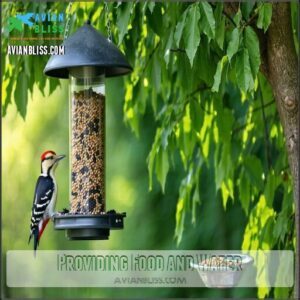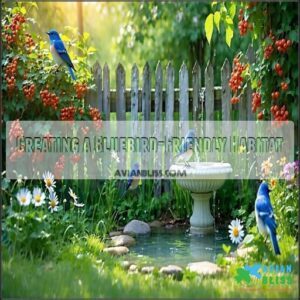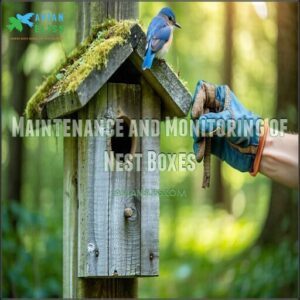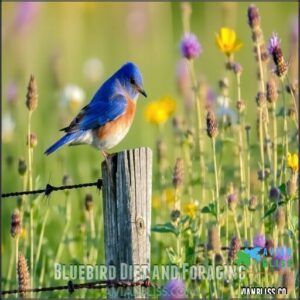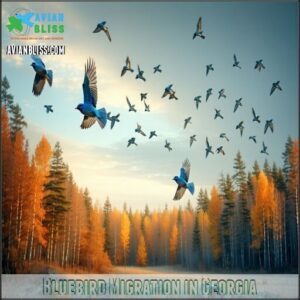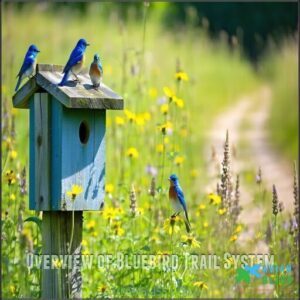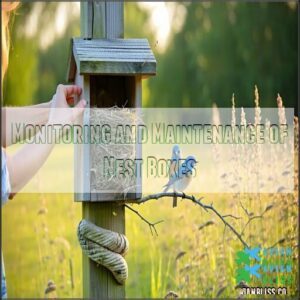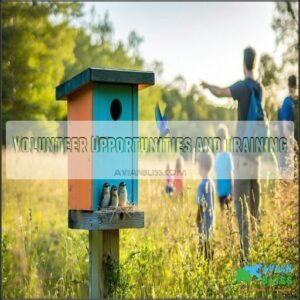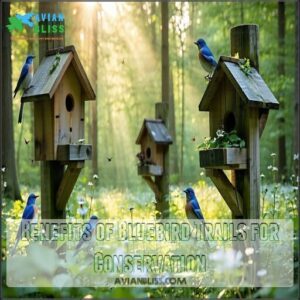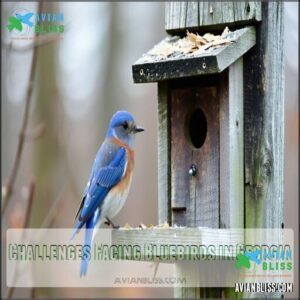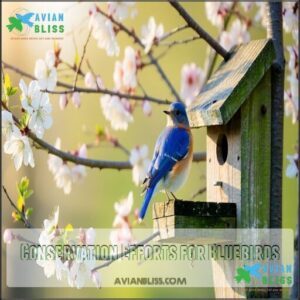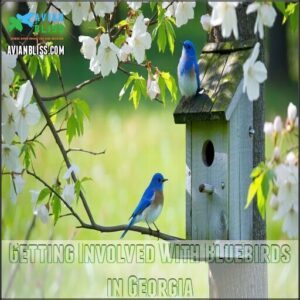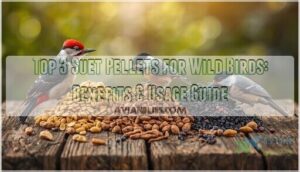This site is supported by our readers. We may earn a commission, at no cost to you, if you purchase through links.
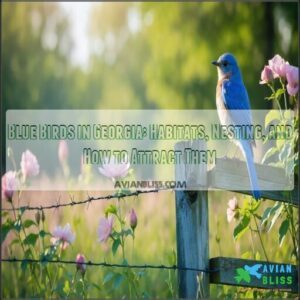
The Eastern Bluebird is your backyard celebrity with its brilliant azure plumage and rusty breast.
Blue Jays announce their presence with bold calls – nature’s alarm clock at dawn.
For a true blue spectacle, watch for the Indigo Bunting, whose feathers appear to glow electric-blue in sunlight.
Blue Grosbeaks prefer brushy fields and woodland edges, where their deep cobalt coloring stands out against green foliage.
Each blue bird in Georgia occupies its own ecological niche, from suburban gardens to rural meadows.
Their specific nesting habits might surprise even seasoned birders, with the variety of species showcasing unique characteristics, such as the backyard celebrity status of some birds.
Table Of Contents
- Key Takeaways
- Bluebirds in Georgia
- Bluebird Nesting Habits
- Bluebird Nesting Season in Georgia
- Attracting Bluebirds to Your Yard
- Bluebird Diet and Foraging
- Bluebird Migration in Georgia
- Bluebird Trails in Georgia
- Challenges Facing Bluebirds in Georgia
- Conservation Efforts for Bluebirds
- Getting Involved With Bluebirds in Georgia
- Frequently Asked Questions (FAQs)
- What does a Bluebird look like in Georgia?
- What birds are blue in Georgia?
- Do Bluebirds live in Georgia?
- Are there Blue Jays in Georgia?
- What birds live in a backyard in Georgia?
- Are there any bluebird conservation organizations in Georgia?
- Are there bluebirds in Georgia?
- Are Blue Jays a good bird in Georgia?
- How do you identify birds in Georgia?
- What type of bluebirds are in Georgia?
- Conclusion
Key Takeaways
- You’ll find several blue bird species in Georgia including the Eastern Bluebird, Blue Jay, and Indigo Bunting, each with distinctive azure plumage and unique ecological roles.
- Georgia’s bluebirds thrive when you install proper nest boxes 5-6 feet high with 1½-inch entry holes and predator guards, facing east to catch morning sunlight.
- You can attract bluebirds to your yard by creating insect-rich habitats, offering mealworms in shallow feeders, providing clean water sources, and avoiding pesticides.
- Eastern Bluebirds in Georgia typically raise 2-3 broods between February and September, with each female incubating 3-7 sky-blue eggs for 13-20 days before hatching.
Bluebirds in Georgia
You’ll find bluebirds across Georgia’s fields, forests, and suburban areas, where they thrive year-round.
These vibrant songbirds, known for their striking blue feathers and reddish-orange chests, prefer open spaces with scattered trees and plenty of insects to snack on, which makes them a delight to observe in their natural habitats.
Overview of Bluebirds in Georgia
Georgia bluebirds, especially the striking Eastern Bluebird, brighten up fields, backyards, and forest edges with their vivid blue and rusty hues.
These feathered gems are essential for healthy ecosystems, controlling pests and spreading seeds.
Learning bluebird identification and understanding bluebird habitat in Georgia helps protect them.
By preserving their habitats, you’re not just birdwatching—you’re supporting conservation efforts for Georgia bluebirds and their future.
Bluebird Migration Patterns
Ever notice how bluebirds seem to vanish and reappear with the seasons? Their migration is a delicate dance of survival, guided by Migration Triggers like temperature changes and food availability.
While some eastern bluebirds in Georgia stick around year-round, others undertake short-distance journeys to warmer Wintering Grounds.
Here’s how their seasonal movements unfold:
- Fall (Sept-Nov): Many head south, avoiding colder weather.
- Winter (Dec-Jan): Migrants and resident Georgia bluebirds gather near reliable food sources.
- Spring (Feb-May): They return north to nest and raise young.
- Stopover Sites: Rest stops provide critical refueling for energy.
- Year-Round Residents: Some enjoy Georgia’s mild winters without migrating.
Bluebird sightings in Georgia peak during winter, showcasing their fascinating Migratory Connectivity shaped by Climate Impacts.
Habitat and Distribution in Georgia
You’ll find blue birds in Georgia thriving across diverse landscapes.
From forested regions at tree edges to urban habitats like parks and backyards, they adapt with ease.
Their coastal distribution includes wetlands and marshes, while open fields and meadows also attract them.
The eastern bluebird in Georgia is a common sight, especially in areas with nest boxes.
Seasonal variations influence their activity, but they’re year-round residents in many places.
Exploring bluebird habitats in Georgia offers a chance to connect with these vibrant members of Georgia bird species.
Bluebird Nesting Habits
Bluebirds are fastidious nesters, choosing sites with care and crafting their nests from grass, pine needles, and soft materials.
You’ll often find their nests in cavities or nest boxes, where they raise multiple broods during Georgia’s long nesting season.
Nesting Season in Georgia
The nesting season for bluebirds in Georgia, stretching from February to September, is nature’s bustling workshop.
During this time, you’ll see:
- Males flaunting their brilliant blue feathers to attract mates.
- Fierce territorial disputes over prime nesting spots, including bluebird boxes Georgia residents often install.
- Parents providing thorough care for eggs, ensuring proper egg development and chick growth.
- Nestlings practicing early behaviors essential for fledgling success.
Bluebird nesting Georgia highlights their resilience and adaptability, thriving in diverse bluebird habitats Georgia offers.
Nest Building and Egg Laying
Eastern Bluebirds are fastidious builders, crafting nests from twigs, pine needles, and soft grasses.
These cozy shelters, often found in nest boxes or tree cavities, are placed with care to shield their young.
A typical clutch size ranges from 3-7 bird eggs, their stunning sky-blue coloration adding beauty to the scene.
Watching these feathered architects work in your yard is a treat, showcasing their dedication to creating safe spaces for future nestlings.
Incubation and Hatching
A bluebird’s incubation period is a delicate balance of warmth and patience.
The female gently warms the bird eggs for 13-20 days, guaranteeing ideal conditions for the hatching process.
It’s a quiet yet pivotal phase where life begins to stir within the nest.
- Egg Development: Steady warmth helps embryos grow.
- Parental Care: Females handle most incubation duties.
- Nestling Survival: Proper temperatures guarantee healthy chicks.
- Hatching Process: Chicks emerge, breaking fragile shells.
- Nest Maintenance: Parents keep the nest clean and safe.
Fledging and Parenting
Once those tiny nestlings hatch and grow, they’re ready to take their first leap into the world.
Bluebird parents work tirelessly during this fledgling stage, balancing parental care with teaching survival skills.
You’ll see them:
- Shielding young from predators while they explore.
- Demonstrating foraging techniques and helping chicks find proper nutrition.
- Gradually reducing feeding frequency to encourage independence.
It’s a heartwarming process as wobbly chicks test their wings, learning balance and flight.
With each attempt, their confidence soars.
The mother and father guide their young through nestling development, ensuring fledgling survival in Georgia’s diverse landscapes.
Bluebird Nesting Season in Georgia
Bluebird nesting season in Georgia typically begins in early spring when temperatures start to warm, and insects become more abundant.
You’ll notice these cheerful birds scouting for safe nesting spots, often returning to the same areas year after year, which can be a significant aspect of their behavior.
Timing of Nesting Season
Springtime in Georgia means the First Brood of Eastern Bluebirds begins as early as late February.
Peak Nesting occurs by March, with Clutch Sizes averaging 3-6 eggs. The Incubation Period lasts 13-17 days, ensuring synchronized hatching.
Timing is critical—early nests face frost, while late nests risk fledgling success. Many enthusiasts supplement their diet with nutritious live insects.
| Timing | Activity | Challenges |
|---|---|---|
| Late February | First Brood Begins | Frost Risk |
| March-July | Peak Nesting | Food Availability |
| August | Late Broods | Chick Development Lag |
Nesting Sites and Boxes
For attracting bluebirds in Georgia, a well-placed nest box is key. Position it 5-6 feet high on a pole with predator guards for safety. Face it east to catch morning sunlight and keep it out of busy areas.
Use sturdy materials to withstand weather, and make certain proper ventilation and drainage are provided for comfort. Consider purchasing pre-made bluebird houses for convenience.
- Box Placement: Open areas away from heavy traffic.
- Nest Box Design: Include a cavity size suited for eastern bluebirds.
- Predator Guards: Essential for protection.
- Box Materials: Durable and weather-resistant.
Your thoughtful setup creates a cozy haven for nesting.
Multiple Broods in a Season
Eastern bluebirds in Georgia often raise 2-3 broods yearly, showcasing remarkable parental investment and adaptability.
Each brood averages a clutch size of five eggs, influenced by:
- Resource Availability like insects.
- Seasonal Success tied to weather.
- Nest location for predator safety.
- Parent health affecting chick care.
- Bluebird habitat quality in Georgia.
Supplemental bluebird food options can also boost their health.
These factors guarantee thriving populations!
Challenges and Threats to Nesting
Nesting season for bluebirds in Georgia isn’t without its hurdles. Predator pressure from raccoons and snakes can devastate nests, leaving eggs and chicks vulnerable.
Habitat degradation, driven by urban sprawl, continues to shrink bluebird habitat in Georgia, forcing these birds to compete for limited nesting sites. Invasive species, like house sparrows, often take over nest boxes, creating fierce nest competition.
Weather impacts, including sudden storms or extreme heat, can disrupt breeding cycles and harm young birds. Pesticide use further compounds these challenges by reducing the insects bluebirds rely on for food.
Supporting bluebird conservation in Georgia through proper nest box placement and habitat restoration can help these charming songbirds thrive despite these threats, ensuring the preservation of their breeding cycles.
Attracting Bluebirds to Your Yard
You can attract bluebirds to your yard by offering the right mix of food, water, and shelter.
Installing a well-placed nest box and maintaining it properly will give these vibrant birds a safe place to call home.
Providing Food and Water
Once you’ve got nesting sorted, it’s time to stock your backyard buffet. A well-fed bluebird is a happy bluebird, and offering the right menu makes all the difference. Focus on foods that mimic their natural diet in Georgia.
- Live Mealworms: These are like candy for bluebirds. Place them in a shallow feeder or tray.
- Winter Feeding: Offer dried fruits like raisins or currants during colder months when insects are scarce.
- Water Sources: A birdbath with a gentle drip feature is irresistible—bluebirds love clean, moving water.
- Natural Foods: Plant native berry bushes like dogwood or holly for year-round snacks.
- Avoiding Hazards: Skip offering sugary or processed foods—they’re not part of a healthy bluebird diet.
By catering to their needs, you’ll create a backyard hotspot for attracting bluebirds in Georgia.
Creating a Bluebird-Friendly Habitat
Creating a welcoming space for blue birds in Georgia doesn’t take much effort, but it makes a world of difference.
Start by planting native shrubs and flowers—they’re like a buffet for birds, offering berries, seeds, and shelter. Keep a clean, shallow water source nearby for drinking and bathing; it’s a bird spa!
Add low fences or hedges for safe perching spots and predator control. Skip harsh chemicals in your yard to keep their food sources safe.
- **Watch them perch on hedges, singing cheerful tunes.
- **See them splash joyfully in your birdbath.
- **Enjoy their vibrant colors brightening your backyard.
Installing Bluebird Nest Boxes
A well-placed nest box can make all the difference in attracting blue birds in Georgia.
Mount it 4–6 feet high on a pole, facing open spaces, and add predator guards for safety. Keep box materials simple—bluebirds prefer a clean start.
Make certain easy access for monitoring boxes and box maintenance.
Here’s a quick guide:
| Feature | Ideal Option | Why It Matters |
|---|---|---|
| Height | 4–6 feet | Easy access, safe for birds |
| Location | Open fields | Preferred habitat for nesting |
| Predator Guards | Essential | Keeps predators out |
| Materials | Clean slate | Bluebirds build their own nest |
| Accessibility | Removable panels | Simplifies cleaning and checks |
Maintenance and Monitoring of Nest Boxes
Keeping your nest boxes in tip-top shape is key to attracting bluebirds in Georgia and maintaining a thriving bluebird habitat.
A little effort goes a long way in ensuring these feathered friends feel right at home.
Here’s a simple guide to effective maintenance and monitoring:
- Stick to cleaning schedules: Clean nest boxes at least once a year, preferably after the breeding season.
- Prioritize predator control: Add predator guards to deter raccoons, snakes, and cats from disturbing your bluebirds.
- Inspect regularly: Check weekly for damage, pests, or invasive species like house sparrows.
- Watch for repair needs: Replace broken parts or reinforce loose screws to keep boxes sturdy and safe.
- Collect data: Monitor activity and note nesting patterns.
Citizen science projects love this info!
With proper care, your nest boxes will remain a welcoming haven for eastern bluebirds in Georgia.
Bluebird Diet and Foraging
Bluebirds in Georgia rely heavily on insects like beetles, grasshoppers, and caterpillars, making them expert foragers.
You’ll often spot them fluttering to the ground or perching low to snatch their next meal with precision.
Insect-Based Diet
Bluebirds in Georgia thrive on an insect-based diet, making your yard their ideal dining spot.
These skilled insectivores rely on high-protein meals to fuel their energy-packed lives. From crickets to beetles and caterpillars, their menu shifts with seasonal variation, guaranteeing they always find what’s abundant.
Larval preference, like munching on juicy caterpillars, is common, especially during nesting season when nutrition needs spike. To support their foraging strategies, avoid pesticides, which can harm both insects and birds.
- Why it matters:
- Crickets and beetles provide essential insect nutrition.
- Seasonal insects keep their diet diverse.
- Pesticide-free habitats guarantee their survival.
Your yard could be their next favorite restaurant!
Foraging Techniques and Strategies
Bluebirds are masters of both sky and ground in terms of finding food. You’ll often see their graceful aerial displays as they dart and hover, snagging insects mid-flight—a true showcase of their insect hunting skills.
On the ground, they’re just as skilled, probing bark, grass, and soil for seeds and winter berries.
Bluebirds also engage in cooperative foraging, working together to uncover hidden treats. They’ve even been spotted using mimicry strategies or simple tools, like twigs, to extract insects.
They often spot prey from perches, showcasing their effective hunting techniques.
Here’s a quick breakdown of their foraging techniques:
| Technique | Focus | Examples |
|---|---|---|
| Aerial Hunting | Insects in flight | Flies, moths, dragonflies |
| Ground Feeding | Seeds, insects | Grasshoppers, beetles |
| Cooperative Foraging | Shared effort | Locating berries, insects |
| Tool Usage | Extracting insects | Using twigs for tight spaces |
Supplemental Food Sources
If you’re attracting bluebirds in Georgia, supplemental food sources can make your yard irresistible.
Start with mealworm feeders, a favorite for their high protein. Add winter berries or raisins for a fruity twist—eastern bluebirds love them!
Suet recipes with peanut butter or sunflower bits are perfect for energy boosts, especially in cooler months.
Use bird feeders that accommodate these treats, like tray or hopper styles. Keep seed preferences in mind, such as shelled sunflower seeds, which are a hit.
With thoughtful offerings, you’ll create a bluebird haven that feels like their favorite café.
Importance of Insects in Bluebird Diet
Insects are the secret ingredient to a strong bluebird diet in Georgia.
These protein-packed snacks fuel everything from daily activities to raising chicks. Think of them as nature’s energy bars for eastern bluebirds.
During breeding season, insects like caterpillars and beetles guarantee chicks grow strong and healthy. Seasonal insects, especially larvae, are a favorite, offering easy-to-digest nutrition.
Here’s why insects matter:
- Insect Nutrition: Packed with protein and essential nutrients for survival.
- Larval Preference: Bluebirds love soft-bodied larvae for feeding their young.
- Foraging Efficiency: Insects are abundant and easy to catch in bluebird habitat Georgia.
- Pesticide Impact: Chemicals harm insect populations, affecting bluebird conservation Georgia.
Skip pesticides to keep your yard buzzing with life!
Bluebird Migration in Georgia
You might notice bluebirds in Georgia year-round, but their migration patterns can vary depending on the species and season.
Understanding these movements helps you track their journeys and even prepare your yard as a welcoming stopover.
Timing and Patterns of Migration
As autumn settles in, Georgia’s bluebirds prepare for their graceful southward journey, a marvel of bird migration.
Their timing isn’t random—it’s sparked by a mix of cooler temperatures and dwindling food supplies. These migratory birds rely on an internal compass to navigate, often traveling at night under the stars.
Here’s what makes their migration so fascinating:
- Migration Triggers: Shorter days and colder nights signal their departure.
- Winter Habitats: Warmer southern regions provide food and shelter.
- Nocturnal Migration: Bluebirds prefer nighttime flights to avoid predators.
- Stopover Ecology: Resting spots with food are essential for energy.
- Climate Impacts: Unpredictable weather can delay or reroute their journey.
Keep an eye out for late bluebird sightings in Georgia!
Routes and Stopover Sites
Georgia’s migration corridors act like invisible highways, guiding bluebirds and other bird species through diverse landscapes.
These routes depend on habitat connectivity and stopover ecology, offering critical resources for rest and refueling. From salt marshes to cypress forests, Georgia’s stopover sites are hotspots for bluebird sightings.
Here’s a quick guide to notable spots:
| Stopover Site | Habitat Type | Common Birds |
|---|---|---|
| Jekyll Island | Salt marshes, dunes | Warblers, shorebirds |
| Okefenokee Swamp | Cypress forests, prairies | Raptors, warblers |
| Wassaw NWR | Beaches, forests | Plovers, sandpipers |
| Cockspur Island | Coastal wetlands | Songbirds, warblers |
| Fort Pulaski NM | Maritime forests | Migratory birds |
These sites highlight the importance of resource availability and habitat preservation for bluebird migration in Georgia, emphasizing the need for conservation efforts to protect these critical areas.
Factors Influencing Migration
A bluebird’s migration journey depends on several factors, and it’s not just about flapping wings aimlessly.
These beautiful travelers adapt their paths based on:
- Food Availability: Insects fuel their flight, so less food means shorter distances.
- Climate Change: Unpredictable weather throws off timing and access to resources.
- Habitat Loss: Fewer resting spots make migration harder.
Navigating these challenges shows the resilience of species like the eastern bluebird in Georgia.
They also rely on visual landmarks for navigation.
Protecting habitats guarantees healthier bluebird migration and populations.
Monitoring and Tracking Migration
Tracking bluebird migration in Georgia is easier than ever with modern tools.
Use smartphone apps and tracking technologies to monitor migration patterns and bird species range. Join banding workshops to study stopover ecology and population dynamics firsthand.
By observing bird monitoring data, you’ll uncover conservation implications for these travelers. It’s like being a detective, piecing together their seasonal journeys.
Your efforts help protect their habitats, ensuring safe migration routes for this cherished bird species.
Bluebird Trails in Georgia
You can support bluebird conservation in Georgia by exploring the state’s network of bluebird trails, which feature strategically placed nest boxes monitored by volunteers.
These trails provide safe nesting sites as well as help track bluebird populations and promote their recovery.
Overview of Bluebird Trail System
Creating a Bluebird Trail System is like rolling out the red carpet for bluebirds in Georgia.
These trails promote conservation and connect people with nature while supporting the eastern bluebird population.
Here’s how it works:
- Trail Establishment: Volunteers set up nest boxes in parks, preserves, and open spaces, ensuring proper box placement for nesting success.
- Trail Maintenance: Regular checks keep boxes safe from predators and weather damage.
- Public Education: Trails inspire communities to learn about bluebird identification and attracting bluebirds to their yards.
By joining, you’re not just spotting bluebird sightings—you’re building their future in Georgia’s landscapes.
Monitoring and Maintenance of Nest Boxes
Building on your successful bluebird trail, proper monitoring and maintenance of nest boxes is key to keeping eastern bluebirds thriving in Georgia.
Regular cleaning is non-negotiable – remove old nesting materials once a year to prevent parasites that could harm future broods.
You’ll want to install predator guards to keep hungry snakes and raccoons at bay.
Box placement matters too. Position them 5-7 feet above ground, facing away from prevailing winds, to attract eastern bluebirds while deterring competitors.
During nesting season, check boxes weekly (but never during extreme weather) and keep detailed records of bluebird sightings and activity. Note repair needs like loose hinges or damaged roofs.
Many Georgia bluebird enthusiasts swear by the "tap-and-listen" method – a gentle tap followed by silence means eggs, while chirping indicates hungry nestlings!
Volunteer Opportunities and Training
With nest boxes in place, you’re ready to join Georgia’s vibrant community of bird conservation volunteers.
Organizations across the state offer excellent training opportunities for bird enthusiasts of all experience levels:
- Monitoring Training: Learn proper techniques for checking nestboxes without disturbing bluebird families
- Nestbox Building Workshops: Gain hands-on skills creating homes that attract Georgia birds
- Data Collection Clinics: Master the science of recording valuable breeding information
- Educational Outreach Programs: Develop skills to share your bird watching passion with others
These programs support habitat management efforts as well as connect you with fellow bluebird lovers who share your commitment to protecting these beloved songbirds.
Benefits of Bluebird Trails for Conservation
Beyond just volunteering, bluebird trails deliver remarkable conservation benefits across Georgia.
These interconnected nest box systems boost eastern bluebird population growth and genetic diversity by creating safe breeding zones. When you maintain a trail, you’re expanding essential habitat that had shrunk dramatically in the 20th century.
Your efforts increase community awareness while promoting ecosystem health—bluebirds consume countless insects that might otherwise damage crops or spread disease.
The data collected from trail monitoring provides scientists with invaluable information about bird habitats and migration patterns. By supporting bluebird trails, you’re strengthening conservation efforts for one of Georgia’s most beloved native species, which is a key part of promoting ecosystem health.
Challenges Facing Bluebirds in Georgia
You’ll find that Georgia’s bluebirds face serious threats from predators, habitat loss, and increasingly unpredictable weather patterns linked to climate change.
Nest box competition from non-native species like house sparrows has also contributed to population declines, though dedicated conservation efforts have helped stabilize bluebird numbers in recent years.
Predation and Nesting Threats
Five major predators threaten eastern bluebird nests in Georgia.
You’ll need strategic defenses to protect these beloved birds from harm.
- Raccoons often raid nest boxes, destroying eggs and killing nestlings if boxes lack proper guards
- Black rat snakes can climb poles and devour entire broods of infant birds when no barriers exist
- Feral cats pose significant threats as ground predators, especially to newly fledged bluebirds
- House sparrows, an invasive species, frequently kill adult bluebirds and take over nest boxes
- Hawks may target adult birds feeding near open areas without adequate cover
Install predator guards on nest boxes and position them away from trees where squirrels can jump.
Regular monitoring helps track nest progress while maintaining proper habitat conservation status through your vigilance.
Habitat Loss and Fragmentation
While predators pose immediate threats, habitat loss and fragmentation represent long-term challenges for Georgia’s eastern bluebirds.
Urban sprawl, forest clearing, and farmland expansion steadily eliminate natural habitats these birds depend on.
| Impact | Cause | Solution |
|---|---|---|
| Reduced nesting sites | Road development | Install nest boxes |
| Food scarcity | Urban sprawl | Create native plant gardens |
| Population isolation | Reduced connectivity | Establish wildlife corridors |
You’ll notice fewer bluebirds in areas with extensive development, which is a result of urban sprawl and habitat changes.
Many other species, like the American Robin, also struggle with habitat changes.
Conservation efforts focusing on preserving existing habitats and creating bluebird-friendly spaces in developed areas offer hope for these beloved blue residents, through methods such as installing nest boxes.
Climate Change and Weather Events
While Georgia’s bluebirds have adapted to seasonal changes for generations, climate change presents unprecedented challenges to their survival.
Eastern bluebirds in Georgia face mounting pressures as weather patterns become increasingly erratic:
- Temperature fluctuations disrupt breeding cycles, with early warm spells triggering premature nesting before adequate food is available, leading to food scarcity and reduced survival rates.
- Extreme weather events like hurricanes and floods destroy nesting sites and decimate insect populations critical to bluebird diets, contributing to bird decline across the state.
- Habitat shifts force migration changes as rising sea levels threaten coastal areas where many bluebirds rest during seasonal movements.
Research shows 23% of Georgia’s bird species face climate vulnerability, with breeding impacts most severe during nesting season.
Bird conservation efforts focus on maintaining diverse habitats and providing consistent food sources to help bluebird populations weather these environmental changes.
Human Impact on Bluebird Populations
While changing weather patterns threaten bluebirds, human activities create equally pressing challenges.
Your neighborhood development likely contributes to habitat destruction that’s reducing eastern bluebird populations in Georgia.
Pesticide use decimates their insect food sources, while invasive species and house sparrows increase nestbox competition.
You can help reverse these trends by supporting bird conservation efforts—installing properly designed nestboxes and creating pesticide-free yards that provide safe havens for these beloved birds.
Conservation Efforts for Bluebirds
You’ll find dedicated conservationists across Georgia working to protect bluebirds through habitat restoration, nest box programs, and population monitoring.
You can join these efforts by installing properly designed nest boxes on your property and participating in citizen science projects that track bluebird populations.
Habitat Restoration and Creation
Restoring habitats breathes new life into eastern bluebird populations across Georgia.
Plant native wildflowers, grasses, and shrubs that attract insects – bluebirds’ primary food source. Create open areas with scattered trees for perching, and include reliable water sources like shallow birdbaths.
Reduce pesticides to maintain healthy insect populations essential for bluebird survival. Local conservation initiatives often involve community restoration projects that transform fallow fields into thriving meadows with native plants.
By designing wildlife-friendly spaces in your yard, you’re creating connecting habitats that support nesting bluebirds and boost biodiversity across Georgia’s fragmented landscapes. This approach helps in restoring habitats and maintaining a balance in the ecosystem, which is crucial for the survival of eastern bluebirds.
Nest Box Installation and Maintenance
Through proper nest box installation and maintenance, you’ll create a bluebird haven in your Georgia backyard.
Place boxes on posts 5-6 feet high, facing east or northeast for morning sunshine that keeps nestlings warm. Verify that your box features the critical 1½-inch entry hole—perfect for Eastern Bluebirds but too small for competitors.
Choose untreated cedar or pine with ventilation and drainage holes for durability. Mount metal predator guards beneath boxes to thwart climbing predators.
Establish cleaning protocols: thoroughly clean boxes between broods and do a deep clean after nesting season ends in fall. Regular monitoring (once weekly) lets you track nesting progress without disturbing birds.
With these simple steps, you’ll contribute meaningfully to bluebird conservation while enjoying frequent bluebird sightings from your window.
Research and Monitoring of Bluebird Populations
While nest boxes provide homes, understanding population trends requires dedicated research.
You can contribute to bluebird conservation by joining monitoring programs that track nesting success across Georgia. Volunteers record valuable data on eastern bluebird behavior, migration patterns, and habitat impact.
This citizen science helps ornithologists analyze genetic diversity and population fluctuations.
Your weekly nest box checks create a thorough picture of bluebird health statewide, turning backyard observations into powerful conservation tools.
This process is crucial for understanding population trends.
Community Engagement and Education
Beyond monitoring, community education forms the backbone of bluebird conservation.
You’ll find bird appreciation soaring when you connect with schools through educational workshops and nest box building programs.
Local partnerships create new bird lovers through citizen science projects that track Georgia’s bluebirds.
Public awareness campaigns highlight threats to these beautiful creatures, while bird watchers share their knowledge through community events.
These efforts don’t just protect bluebirds—they build a community that cares about our feathered neighbors, and through public awareness campaigns, they make a significant impact.
Getting Involved With Bluebirds in Georgia
You’ll find meaningful ways to help Georgia’s bluebird populations through monitoring nest boxes, participating in citizen science projects, or joining local conservation groups.
Whether you’re setting up your first nest box or contributing data to statewide research efforts, your involvement directly supports these beloved blue songbirds that brighten our state’s diverse landscapes, which is a great way to make a difference through citizen science projects.
Becoming a Bluebird Monitor or Volunteer
After working to safeguard eastern bluebirds in Georgia, you can roll up your sleeves and join the action yourself! Bluebird monitoring training programs turn casual bird watching into meaningful conservation work.
Organizations across Georgia offer certification to help you learn proper reporting protocols and identification skills.
When you become a monitor, you’ll regularly check nest boxes, record data on eggs, nestlings, and fledglings, and contribute to valuable research that tracks population trends.
- Attend free training sessions with local conservation groups to learn monitoring techniques
- Collect and submit nest box data using standardized forms
- Document eastern bluebird sightings and breeding behavior in your assigned area
- Help maintain bluebird trails at parks like Cooper Creek and Flat Rock to support eastern bluebird conservation efforts and participate in conservation work.
Participating in Citizen Science Projects
Citizen science creates a bridge between your backyard bird watching and meaningful eastern bluebird conservation.
Join NestWatch to track nesting behaviors through brief seasonal visits, or participate in Climate Watch’s winter and summer surveys of bluebird populations.
Your data collection through eBird helps scientists analyze climate change impacts on common Georgia birds.
These project types develop your bluebird identification skills while contributing to essential research.
No experience? No problem! Programs offer volunteer training for identifying birds in Georgia.
You’ll gain valuable skill development while joining a community that shares your passion for georgia bird watching.
The projects available include Citizen Science, Volunteer Training, and Community Outreach, each with its unique contribution to conserving bird species.
Supporting Local Conservation Efforts
Through local conservation efforts, you can help Georgia’s eastern bluebirds thrive for generations to come.
Here’s how to make a difference:
- Support habitat preservation by joining wildlife organizations like Georgia Audubon
- Donate to bluebird population funding initiatives
- Volunteer for education programs at nature centers
- Participate in bird habitat monitoring with local conservation groups
Your involvement directly strengthens protection for these beloved blue residents.
You can also assist with monitoring bird populations as a conservation project to help with the bluebird population.
Learning More About Bluebirds and Their Needs
Curious minds can expand their eastern bluebird Georgia knowledge through the North American Bluebird Society, your go-to resource for bluebird identification Georgia.
You’ll master nestbox placement techniques and habitat enrichment strategies by joining their educational programs.
Learn about bluebird diet Georgia variations and winter survival tactics through interactive workshops.
Document your attracting bluebirds Georgia success and share bluebird sightings Georgia with fellow enthusiasts.
Their website offers science-based guides on diet variety and seasonal needs – turning you from casual observer to bluebird champion in no time!
Frequently Asked Questions (FAQs)
What does a Bluebird look like in Georgia?
In Georgia, you’ll find Eastern Bluebirds with bright blue backs, rusty-orange breasts, and white bellies.
Males are more vibrant than females, who’ve grayish-brown wings with blue highlights and muted orange breasts.
What birds are blue in Georgia?
You’ll find the Eastern Bluebird, Blue Jay, Indigo Bunting, Black-throated Blue Warbler, and Belted Kingfisher in Georgia. Each displays distinctive blue plumage with varying patterns and habitat preferences.
Do Bluebirds live in Georgia?
Yes, Eastern Bluebirds live year-round in Georgia. You’ll find these stunning blue-backed birds with rusty-orange breasts in semi-open areas like forest clearings, farms, and suburban lawns throughout the state.
Are there Blue Jays in Georgia?
Blue Jays absolutely thrive in Georgia, residing there year-round. You’ll spot these noisy, vibrant birds in your yard, recognizable by their bright blue feathers, distinctive crest, and bold personalities.
What birds live in a backyard in Georgia?
Like a vibrant tapestry, your Georgia backyard can host Cardinals, Chickadees, Mockingbirds, Robins, Blue Jays, Hummingbirds, and Bluebirds. You’ll often see them gathering around feeders or splashing in birdbaths.
Are there any bluebird conservation organizations in Georgia?
While Georgia doesn’t have state-specific bluebird organizations, you’ll find support through the North American Bluebird Society (NABS), which promotes bluebird conservation nationwide.
LaFayette Bluebird Hollow Farm also specializes in Eastern Bluebird conservation and education.
Are there bluebirds in Georgia?
You’ll find an absolute treasure trove of Eastern Bluebirds across Georgia.
They’re permanent residents in the state, often perching on telephone poles or visiting your backyard nest boxes throughout the year.
Are Blue Jays a good bird in Georgia?
You’ll appreciate Blue Jays in your Georgia yard for their intelligence and striking blue plumage. They’re valuable ecosystem contributors, controlling insect populations, despite sometimes being noisy and intimidating smaller birds.
How do you identify birds in Georgia?
Despite seeming overwhelming at first, you’ll identify Georgia birds by observing size, color patterns, behaviors, and songs. Learn to use field guides and birding apps while practicing in your backyard.
What type of bluebirds are in Georgia?
You’ll find Eastern Bluebirds year-round in Georgia’s open areas. Blue Jays, though not true bluebirds, are common residents too. Indigo Buntings visit during summer with their stunning all-blue plumage.
Conclusion
You’d think Georgia’s blue birds would be hard to attract, but they’re surprisingly enthusiastic houseguests.
By installing proper nest boxes, creating insect-friendly habitats, and providing clean water sources, you’ll soon welcome these azure visitors to your yard.
Whether it’s the Eastern Bluebird’s cheerful song or the Indigo Bunting’s electric display, blue birds in Georgia offer both pest control and natural beauty.
Your efforts to support these feathered neighbors contribute substantially to their conservation across the state.
- https://www.allaboutbirds.org/guide/Blue_Jay/overview
- https://lcmcd.com/faqs/do-purple-martins-help-reduce-mosquitoes/
- https://www.georgiabackyardnature.com/georgia_backyard_nature/2010/11/bright-blue-jays.html
- https://www.audubon.org/field-guide/bird/little-blue-heron
- https://www.journals.uchicago.edu/doi/abs/10.1086/695439

